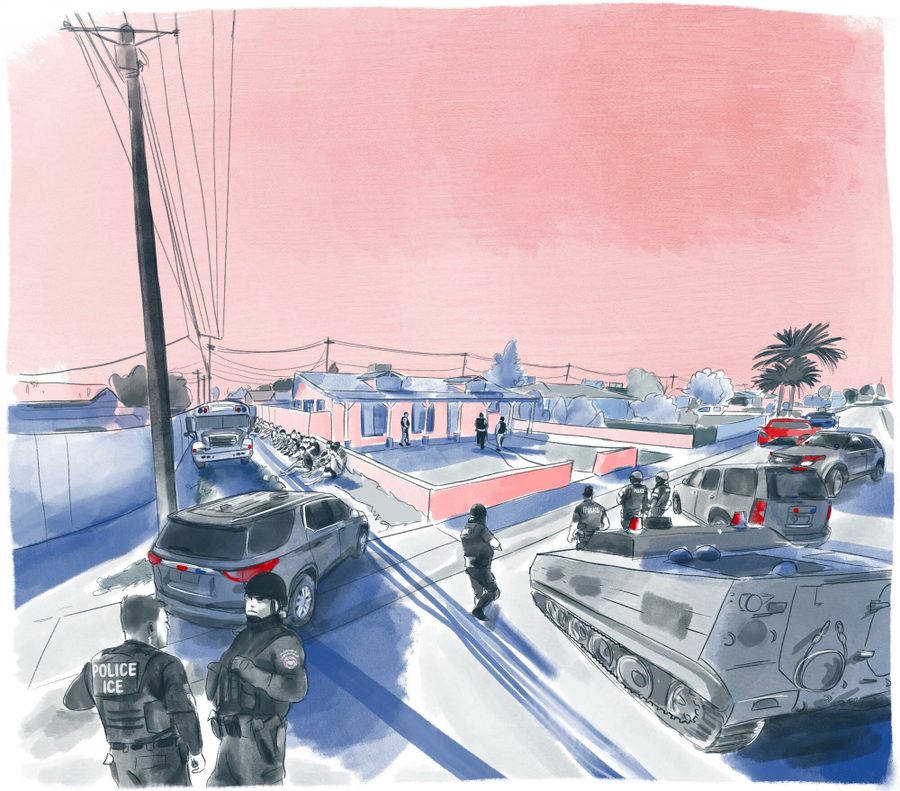Biden's Treatment of Asylum-Seekers Looks a Lot Like Trump's
Migrants are being whisked away in the night, without a hearing, on “public health” grounds.
Tina Vásquez

This piece is published in collaboration with Prism.
A man calls the Phoenix Police Department on January 29 — his uncle has been kidnapped. Smugglers are holding his uncle at a drop house. They had helped his uncle, a newly arrived undocumented immigrant, cross the border. Now, they want more money.
After the police arrive, agents from Immigration and Customs Enforcement show up. They apprehend the uncle and dozens of migrants from Mexico, Guatemala, Honduras and Nicaragua, including three children.
So far, the events that unfolded are disturbing but standard practice. In Phoenix, local police and federal immigration authorities have long cooperated.
But what happened next was part of something new.
To find out where these migrants were taken, grassroots migrant justice organization Puente Human Rights Movement tapped its network of activists and legal advocates. Some were detained at the Florence Correctional Center in Florence, Ariz. Others, at the Eloy Detention Center in Eloy Ariz. According to advocates (who spoke with one migrant’s family members), the migrants were never asked if they were asylum seekers, and they were never asked to participate in a criminal investigation into human trafficking, which could have earned them temporary immigration visas.
Instead, advocates say, the migrants were held and expelled under an obscure provision in U.S. Code Title 42, the part of the law that covers public health and welfare. President Donald Trump weaponized Title 42 during the Covid-19 pandemic as a way to expel border-crossers more quickly and with less fuss, a practice that continues under President Joe Biden.
Title 42 Explained
The Trump administration invoked Title 42 early in the Covid-19 pandemic, under the pretense of protecting public health, to authorize Customs and Border Protection (CBP) to expel migrants without documentation near the border or at ports of entry. Migrants subjected to Title 42 are whisked away, leaving almost no trace in the U.S. immigration system.
That mechanism — expulsion — is different from deportation.
In deportation, migrants are first admitted into the United States. They receive an Alien Registration Number, or A-Number. And, unless they qualify for “expedited removal,” they get to appear before a judge. Even in expedited removal cases, asylum seekers who pass a “credible fear interview” get a hearing. No matter how broken and punitive the process is, there is, at least, a process. Expulsion results in the same ejection of migrants from the United States, but without any of this process.
Title 42 has sealed the border in a way that anti-immigrant zealot Stephen Miller, a top Trump aide and the policy’s biggest proponent, could have only dreamt of.
At the start of the pandemic, Title 42’s forerunner, the 2019 Remain in Mexico policy, had already pushed approximately 60,000 asylum seekers to Mexico — people who previously would have been allowed to wait in the United States for their cases to be adjudicated. At the urging of Miller, the Trump administration effectively closed the border using Title 42. Remain in Mexico hearings were indefinitely postponed and newly arrived migrants — including asylum seekers — were expelled.
Of course, for the anti-immigrant Trump administration, public health concerns were a mere fig leaf. According to the Associated Press, experts at the Centers for Disease Control and Prevention balked at the Title 42 order, saying there was no evidence it would slow the virus. Public health experts stated that there was no scientific justification for the policy. Masks, social distancing and screening measures at the border could make migration safe.
Crucially, experts noted, the government would also need to stop holding newly arrived migrants in group detention centers and instead allow them to shelter with their families or community contacts in the United States. These alternatives to detention programs have existed for years, enabling asylum seekers to reside in the United States as their cases are adjudicated.
Beginning in February, the Biden administration began its slow reversal of Remain in Mexico (frustrating those who wanted it immediately rescinded) by processing a couple dozen asylum seekers a day in some ports of entry, including San Diego and El Paso.
Title 42 expulsions continue on a daily basis.
On February 10, White House Press Secretary Jen Psaki had a message for migrants seeking life-saving asylum: “Now is not the time to come.” Psaki cited Biden’s limited time in office as the reason “a humane, comprehensive process for processing individuals” at the border does not yet exist. In the meantime, Psaki said, a “vast majority of people will be turned away.”
Trump’s Kids
Outrage over the Trump administration’s Title 42 expulsions exploded in summer 2020 after federal immigration authorities secretly contracted with a private security firm to detain children and families at hotels. Unaccompanied children were of particular concern.
Otherwise known in the immigration system as “unaccompanied alien child[ren],” these minors migrate alone to the United States without authorization. In theory, minors have significantly more protections than adults, because of laws such as the Trafficking Victims Protection Reauthorization Act and the Flores settlement agreement (which outlines basic standards of care for immigrant children in federal custody). Before being sent back across the border, Mexican and Canadian children must be screened to determine if they are trafficking victims, eligible for asylum, or can’t make decisions for themselves. Unaccompanied children from other countries are transferred to the custody of the Office of Refugee Resettlement, where they are detained in shelters or placed with a sponsor (typically a family member) until a judge hears their case.
This process for unaccompanied children impeded the Trump administration’s ability to deport newly arrived children as easily as it wanted. So, instead, under Title 42, children as young as one year old were put into black sites under the supervision of unlicensed transportation workers employed by a private company, contracted by Immigration and Customs Enforcement (ICE).
The Texas Civil Rights Project (TCRP) spoke with some of these children. According to TCRP senior attorney Karla Marisol Vargas, the organization learned that there were children held in hotel rooms, watched over by guards, for days. Phone calls were generally forbidden. This meant children could be driven to the airport for expulsion flights in the middle of the night, with many of their families not even knowing they had been in federal custody.
Beyond violating asylum laws, the Trump administration’s use of Title 42 also created a shadow system that made tracking these migrants impossible.
There was no record of these children in the regular immigration system, no A-Number, no information about where they were detained. It was as if they didn’t exist, according to Vargas, who has advocated for children subject to Title 42. Attorneys eventually learned these children instead received Title 42 identification numbers, which were entered into a shadow tracking system.
An ongoing class action lawsuit from the American Civil Liberties Union on behalf of unaccompanied asylum-seeking children prompted a judge in November 2020 to block the federal government’s ability to continue using Title 42 to detain children in black sites. Another court reversed the ban on January 29, but there have been no reports to date of children being held in hotels under the Biden administration.
The use of Title 42 to expel adults who cross the border without documentation, however, continues.

Biden’s Migrants
Presently, under Title 42, adult migrants found at the border without documentation (who are not “amenable to immediate expulsion to Mexico or Canada,” per a CBP memo) are detained, then expelled to their home country. Border Patrol’s “portable command stations” process migrants in the field, allowing “expeditious” expulsion — meaning they are transferred to ICE custody, where, in the name of public health, they are detained in crowded facilities where Covid-19 is known to spread. ICE then expels these immigrants (and the virus, if they have contracted it) all over the world.
In total, between March 2020 and January 2021, Title 42 was used more than 450,000 times at the U.S.-Mexico border. Many of these people would otherwise have undergone the asylum process.
In the first 11 days of February, the Biden administration commissioned planes to fly about 900 Haitians seeking asylum back to Port-au-Prince under Title 42, according to an analysis by Jake Johnston of the Center for Economic and Policy Research.
On February 23, more than 60 members of Congress signed a letter to Homeland Security Secretary Alejandro Mayorkas calling for an end to Title 42 expulsions, focusing specifically on expulsions to Haiti.
“Many migrants are at high risk of exposure to Covid-19 while being detained in the United States pending their expulsion or deportation to less-resourced countries with severely strained health systems,” the letter says. “Haiti, for example, has only 124 [intensive care] beds and the capacity to ventilate 62 patients for a country of 11 million. The island nation also is mired in severe economic, security, and constitutional crises, yet has received more than 900 migrants since February 1. This includes a recent February 8 flight in which 72 people were deported to Port-au-Prince, including a two-month-old baby and 21 other children.” (Although the letter used the term “deported,” this was actually an expulsion.)
Red Flags
The use of Title 42 in Arizona is unprecedented.
Phoenix is a major metropolitan area that is a 150-mile drive from the nearest U.S. border, far from where enforcement of Title 42 would be expected, given that the policy is directed at people in the act of crossing over. But in September 2020 and January 2021, under Title 42 — in different operations and during different presidential administrations — advocates report at least 125 newly arrived migrants were apprehended and processed.
The morning of Sept. 16, 2020, Sandra Solis, director of organizing and movement building for Puente, received a text message from a colleague about a multi-agency raid unfolding in Phoenix. Solis is accustomed to providing support when immigrant communities are targeted, but when she arrived at a home on residential 27th Avenue, something seemed off.
According to Solis, the chaotic scene included about 30 officials with the Department of Homeland Security (including CBP), the Phoenix Police Department and the Drug Enforcement Administration (DEA). Undercover officers mixed with armed officers in paramilitary gear as unmarked SUVs and trucks — and a tank — stood in front of the house. Migrants apprehended in the raid were herded into vans parked in an alley.
Solis says she became suspicious because CBP and DEA officials were on the scene — two agencies that almost never participate in Phoenix-area immigration raids. Later that day, in nearby Chandler, a similar raid was staged. Grassroots organizers and legal advocates were able to determine the migrants apprehended were expelled from the United States within hours.
No records of these migrants exist by A-Number in the U.S. immigration system, Solis says. They were disappeared.
The speed of the expulsions meant Puente was unable to establish contact with the migrants. Advocates never learned if they were trafficked or asylum seekers.
“The city of Phoenix has its own protocol for when people are victims of trafficking [and] essentially this was trafficking,” Solis says. “All of these people should have been provided U-Visas [for victims of crime]. Instead, they were [expelled] without due process.
“I think that’s one of the biggest, most important things to note: They’re utilizing Title 42 to deny people who are victims of trafficking.”
Local news outlets reported on the raids and cited narcotics search warrants, potential criminal activity and the apprehension of several dozen people “suspected of entering the country illegally,” but only one referenced Title 42.
The use of Title 42 was confirmed, however, by Javier Gurrola, CBP executive officer of law enforcement operations, in an email to Losmin Jiménez, who worked in partnership with Puente as a former senior attorney at the Advancement Project, a racial justice nonprofit in Washington, D.C. First, he confirmed Border Patrol participated in a “multi-agency operation” Sept. 16, 2020, in two Phoenix-area locations, and took custody of 65 people, including unaccompanied minors, suspected of being undocumented.
Then, the email reads: “The majority of these detainees have been processed as per [Centers for Disease Control and Prevention] guidelines (T42) to prevent the introduction of Covid-19 into the United States.”
Solis says the multi-agency September raids remind her of how Arizona has piloted a partnership between local law enforcement and federal immigration authorities before, with a 2010 law known as SB 1070 that attracted attention and outrage nationwide for explicitly allowing racial profiling. The law, at the time, was the strictest anti-immigrant measure in the United States. Portions of the law were struck down by the Supreme Court, but the “papers please” provision that critics say allows racial profiling was not— meaning that police officers in Arizona are still required to make a reasonable attempt to determine the immigration status of anyone lawfully stopped if the officer has “reasonable suspicion” they are undocumented.
Copycat bills were introduced in other states, although most failed to make it into law.
SB 1070 solidified a police-ICE partnership in Arizona, creating what advocates call a poli-migra state, a slang term used in some Spanish-speaking immigrant communities to refer to the coordination of local police with federal immigration authorities.
Expelling Victims
Even before Arizona’s SB 1070 law, the state had a history of piloting deeply harmful immigration policies and practices. For example, in 2006, Arizona became one of the first places to implement Operation Streamline, under the radar. This joint Homeland Security and Justice Department initiative created “zero-tolerance immigration enforcement zones” in which authorities could criminally prosecute migrants for “illegal entry” — where, previously, Mexican migrants would be returned to Mexico and non-Mexican migrants would have to appear before an immigration judge.
In effect, Operation Streamline pioneered the “crimmigration” system the U.S. now has, in which undocumented migrants are prosecuted through the criminal justice system, rather than processed through the civil immigration system.
Advocates with Puente fear it’s only a matter of time before immigration authorities use Title 42 to expel migrants in cities beyond Phoenix — if it’s not happening already.
After the September 2020 raids, Jiménez thought the use of Title 42 so far from the border could have been a “one-off thing.” Then, it happened again.
On January 29, someone called Puente’s crisis line to report a number of unmarked vehicles in front of a house on 14th Avenue. There are few media reports about the January 29 raid, but a statement to Prism and In These Times from Mercedes Fortune, Phoenix Police Department public information sergeant, confirms police responded to a caller reporting “a person who was being held against their will.”
Officers found more than 50 people inside the residence and “determined the persons were involved in human smuggling,” according to the February 19 statement. “The United States Immigration and Customs Enforcement were advised and they have taken over the investigation.”
In instances of suspected human trafficking, the Phoenix Police Department is supposed to perform its own investigation. According to the department’s Operations Order 4.48, the “papers, please” provision of SB 1070 does not apply if it may hinder an investigation by undermining cooperation. The order notes, in particular, the need for “significant cooperation of those involved” in human trafficking cases.
Instead, in the January 29 raid, the Phoenix Police Department appears to have simply handed the case to ICE. The police department did not respond to a query about whether it was conducting its own investigation. ICE, in an emailed statement to Prism and In These Times, says it took 60 people to the ICE office for processing. From there, according to advocates, the migrants wound up at the Florence and Eloy Detention Centers. (The Eloy Detention Center, in June and July of 2020, had one of the largest coronavirus outbreaks of any immigration detention facility in the country, and both centers had confirmed cases as of January.)
Solis and her colleagues at Puente maintain ICE processed the migrants under Title 42, based on information from someone who was picked up in the raid and held at Eloy. (The names of undocumented migrants and their family members have been withheld for their protection.) Puente says it confirmed with a legal-aid attorney that the person was detained at Eloy and that they do not appear to have an A-Number. Since this person’s release, members of Puente say another aid group has confirmed similar Title 42 findings.
A great deal of murkiness still surrounds the use of Title 42, including whether ICE even has authority to use it. The Trump administration’s original memo outlining the use of Title 42 was directed at CBP and “specifically the United States Border Patrol,” separate from ICE. In the first Arizona raid in September 2020, CBP was at the scene; at the January raid, advocates saw only ICE and the Phoenix Police Department.
When asked directly whether ICE has authorization to process newly arrived undocumented migrants under Title 42 without coordination from CBP, ICE spokesperson Alexx Pons would only say Title 42 is within the purview of CBP and “expulsions under Title 42 are not based on immigration status and are tracked separately from immigration enforcement actions.”
ICE referred further questions to CBP. CBP did not respond to repeated requests for comment.
A Rogue System
The raids that unfolded around Phoenix are perhaps the first (documented) cases of Title 42 used to expel migrants far from the borders.
It is relevant to note that, while many associate CBP directly with the U.S. border, its reach is actually much larger. It has authority within 100 air miles of any land border or coastline, a territory that encompasses Phoenix, New York and many other major cities. According to the American Civil Liberties Union, nearly two-thirds of the U.S. population resides within CBP’s jurisdiction — in other words, the territory where Title 42 grants CBP license to quickly expel newly arrived migrants under the guise of public health.
That the Biden administration has so far chosen to continue Title 42 expulsions may surprise some, but not Solis. The community organizer anticipated Biden taking an “Obama-style” approach, a nod to the raids and mass deportations that occurred during President Barack Obama’s years, when Biden was vice president.
“The people affected the most are those whose lives are affected by the immigration system, and this administration’s not really doing anything super proactive,” Solis says. “Title 42 is serving its purpose. It’s doing what [Homeland Security] intended it to do, which is create a rogue system.
“Regardless of the presidency, when it comes to immigration, there’s always a rogue system.”
Paco Alvarez and Brianna Bilter provided fact-checking.

I hope you found this article important. Before you leave, I want to ask you to consider supporting our work with a donation. In These Times needs readers like you to help sustain our mission. We don’t depend on—or want—corporate advertising or deep-pocketed billionaires to fund our journalism. We’re supported by you, the reader, so we can focus on covering the issues that matter most to the progressive movement without fear or compromise.
Our work isn’t hidden behind a paywall because of people like you who support our journalism. We want to keep it that way. If you value the work we do and the movements we cover, please consider donating to In These Times.
Tina Vásquez is a journalist with more than a decade of experience reporting on immigration, reproductive injustice, gender, food, labor, and culture. Currently she is the editor-at-large at Prism and she serves on the board of Press On, a Southern journalism collective that strengthens and expands the practice of journalism in service of liberation.






